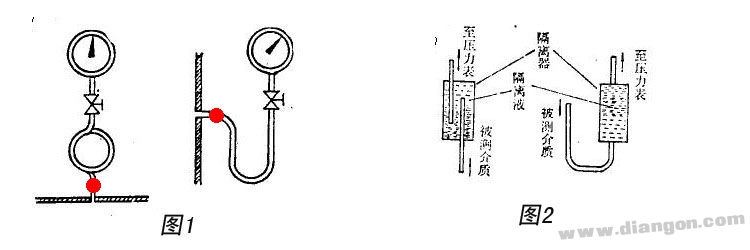Pressure gauges are commonly installed on-site with a surface diameter of 100mm. If the installation height is high or lighting conditions are poor, larger sizes such as 150mm or 200-250mm can be used. Before installation, the pressure gauge must be calibrated and only installed after passing the test. It should be fixed to a specially machined joint and properly shimmed, not wrapped or directly attached to the valve. The installation location should be convenient for operation and maintenance.
To ensure accurate measurement, the pressure point must be representative. Choose a straight pipe section with smooth flow, avoiding bends. The pressure pipe should not extend into the equipment or piping. For horizontal or inclined pipelines: when the medium is gas, install in the upper half; when it's steam, within 0-45 degrees from the upper part to the horizontal centerline, preferably on the horizontal line; when it's liquid, in the lower half within 0-45 degrees from the horizontal centerline. If conditions limit, choose a suitable position based on actual circumstances.

When installing a pressure gauge for media with temperatures above 60°C, such as steam, a ring or U-bend should be added between the pressure tap and the gauge valve to prevent overheating damage. In some cases, the valve is shown at the root in control drawings, but this exposes it to high temperature, increasing the risk of leakage or failure. Installing the valve as shown in Figure 1 keeps it at normal temperature, significantly extending its lifespan, which has been proven through years of practice.
When measuring pulsating pressure from compressors or pumps, a buffer or throttle can be installed before the pressure gauge to protect it and improve accuracy. A damping valve may also be added to increase resistance when pressure changes rapidly.
If the medium contains dust, particles, or impurities, the pressure tube should be thickened, and a dust collector or drain valve may be installed for cleaning. A water separator should be used for humid gases. For isolators used in special applications, refer to Figure 2 for the correct installation method.
The distance between the pressure gauge and the tapping point should be as short as possible to avoid measurement lag. The maximum length of the pressure guide tube should not exceed 50 meters. If it's too long, consider using a remote pressure gauge. For crystalline media, a live joint should be installed for easy disassembly.
When installing low-pressure gauges, avoid the static pressure effect caused by liquid columns. For critical equipment, two pressure gauges can be installed separately to reduce accident risks. Regular maintenance and calibration according to schedule are essential for reliable pressure measurement and production safety.
DSD Composite offers wildly range of Ladder Type Cable Trays made of FRP (Fiberglass Reinforced Plastic). These FRP Cable Trays are used for installation of power cables and control cables. It is manufactured using highest quality of FRP pultruded material, which is extremely durable and resistant to various chemicals environments.
Ladder Type FRP cable trays are suitable for the laying of larger diameter cables, this type of FRP cable trays has the characteristics of lightweight, low cost, heat dissipation, good air permeability.
FRP Cable Tray,frp tray,channel cable tray,grp cable tray,frp ladder tray
Hebei Dingshengda Composite Material Co., Ltd. , https://www.frpdsd.com